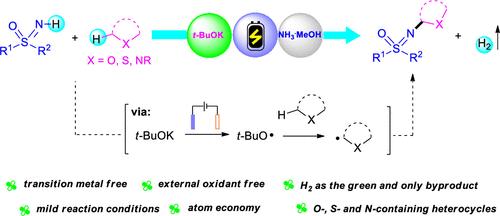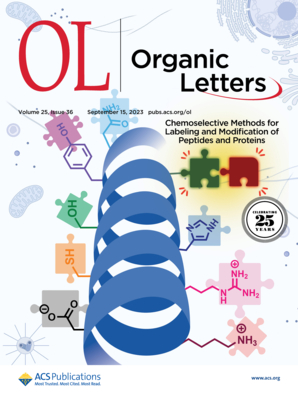t- buok诱导,NH3·meoh促进饱和杂环与亚砜胺的电化学C(sp3)-H胺化。
IF 5
1区 化学
Q1 CHEMISTRY, ORGANIC
引用次数: 0
摘要
报道了t- buok诱导饱和杂环与亚砜胺的C(sp3)-H电化学胺化反应。利用t-BuOK而不是危险的过氧化物作为电化学诱导叔丁基自由基的前体;这一过程以前没有报道过。值得注意的是,我们发现NH3·MeOH可以作为电化学氧化反应的促进剂。该C-H/N-H交叉脱氢偶联反应只产生绿色副产物H2,具有原子经济性、不含过渡金属、不需要外部氧化剂、反应条件温和等优点。本文章由计算机程序翻译,如有差异,请以英文原文为准。

t-BuOK-Induced, NH3·MeOH-Promoted Electrochemical C(sp3)–H Amination of Saturated Heterocycles with Sulfoximines
The t-BuOK-induced electrochemical C(sp3)–H amination of saturated heterocycles with sulfoximines was reported. t-BuOK rather than dangerous peroxides was used as the precursor of the tert-butoxy radical, which was induced by electrochemistry; this process has not been previously reported. Notably, we found that NH3·MeOH can serve as a promoter in electrochemical oxidation reactions. This C–H/N–H cross-dehydrogenation coupling reaction produces only the green byproduct H2 and has the advantages of atom economy, lack of transition metals, lack of external oxidants, and mild reaction conditions.
求助全文
通过发布文献求助,成功后即可免费获取论文全文。
去求助
来源期刊

Organic Letters
化学-有机化学
CiteScore
9.30
自引率
11.50%
发文量
1607
审稿时长
1.5 months
期刊介绍:
Organic Letters invites original reports of fundamental research in all branches of the theory and practice of organic, physical organic, organometallic,medicinal, and bioorganic chemistry. Organic Letters provides rapid disclosure of the key elements of significant studies that are of interest to a large portion of the organic community. In selecting manuscripts for publication, the Editors place emphasis on the originality, quality and wide interest of the work. Authors should provide enough background information to place the new disclosure in context and to justify the rapid publication format. Back-to-back Letters will be considered. Full details should be reserved for an Article, which should appear in due course.
 求助内容:
求助内容: 应助结果提醒方式:
应助结果提醒方式:


